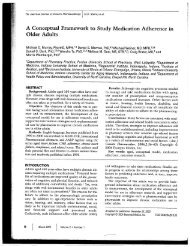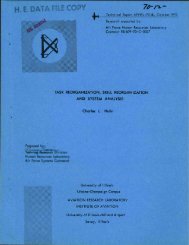Usability Questionnaire Results - Institute of Aviation - University of ...
Usability Questionnaire Results - Institute of Aviation - University of ...
Usability Questionnaire Results - Institute of Aviation - University of ...
You also want an ePaper? Increase the reach of your titles
YUMPU automatically turns print PDFs into web optimized ePapers that Google loves.
substantially different from the tasks <strong>of</strong> the system operator, which are in turn quite differentfrom those <strong>of</strong> the marketer or the engineer making presentations to regulators. In this experimentthe task focused on was the traditional process control task that required both detection (focusedattention) and diagnosis (integration) <strong>of</strong> system failures.The second issue is how closely the experimental setup matches what actually occurs inpractice. The goal in the setup <strong>of</strong> this experiment was to provide results that would help todesign the next generation displays for use by either electric utility operators or operationalplanning engineers. Therefore in the contextual setup <strong>of</strong> the experiment the goal was to at leastroughly approximate a utility control environment in which an operator responds to a systemvoltage disturbance, such as the one faced by the Delmarva Power and Light (DPL) operators onJuly 6 th 1999 during which their system experienced a near voltage collapse following the loss <strong>of</strong>the Indian River 2 generator (Interim Report <strong>of</strong> the U.S. Department <strong>of</strong> Energy’s Power OutageStudy Team, 2000).To completely replicate such a situation, and then test the response <strong>of</strong> the operators tovarious system visualizations would be quite difficult because <strong>of</strong> the complexity <strong>of</strong> powersystems control. In the initial stages <strong>of</strong> the research project reported here the experimental setupwas admittedly <strong>of</strong> lower fidelity than that in a control center environment, in which experiencedoperators or engineers monitor and control a system <strong>of</strong> which they are quite familiar usingdisplays they have used for years. Nevertheless, the experimental setup used in this experimentshould be viable and a good platform for evaluating future enhancements proposed forimplementation into the operation setting.Given these considerations, the question <strong>of</strong> whether the new display formats show thebenefits predicted by the human factors research were investigated by conducting an experimentwhere participants had to use one <strong>of</strong> three display formats to solve problems in power systemgrids. The first display simulated the tabular information and static map board that real lifepower system operators currently use. The second display (similar to Figure 1-1) utilized anintegrated one-line diagram display format and the third display (Figure 1-2) utilized anintegrated one-line diagram display format with a color contours enhancement. The first taskthat participants had to do was detect and acknowledge voltage problems in a power grid systemwhen they occurred. This task had low task proximity since focused attention was required toread individual voltage values. The second task that participants performed was to correct orsolve the voltage problems by opening and closing capacitors. This task had high task proximitysince information needed to be integrated, and hence ideally attention was divided betweencapacitor location information and bus voltage value information. These sources <strong>of</strong> informationrequired integration to perform the solving task.The proximity compatibility principle predicts that the integrated displays should bebetter at the high mental proximity task <strong>of</strong> solving problems in a power system, but they may beworse in the focused attention task <strong>of</strong> finding all voltage value violations. It also predicts that thetabular display and static map board should lead to worse performance for subjects performingthe high mental proximity task <strong>of</strong> solving. The tabular display and static map board shouldbetter support detecting/finding all voltage problems in a power grid since the perceptualorganization <strong>of</strong> buses and voltages into a single column is predicted to decrease visual searchtime. The location <strong>of</strong> violations displayed in the integrated one-line diagram display are not19















